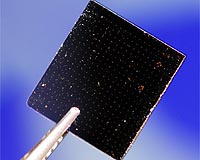 |
Dresden, Germany (SPX) Apr 21, 2011 Just in time for the 100th anniversary to commemorate the discovery of superconductivity by the Dutch physicist Heike Kamerlingh Onnes on April 8, 1911, scientists from the Helmholtz-Zentrum Dresden-Rossendorf and the TU Dresden published their research results in the journal Physical Review B. Headed by Dr. Thomas Herrmannsdorfer, the team from the HZDR's High Magnetic Field Laboratory (HLD) examined a material consisting of the elements bismuth and nickel (Bi3Ni) with a diameter of only a few nanometers - which is unique since it has not been achieved elsewhere so far. This was made possible through a new chemical synthesis procedure at low temperatures which had been developed at the TU Dresden under the leadership of Prof. Michael Ruck. The nano scale size and the special form of the intermetallic compound - namely, tiny fibers - caused the physical properties of the material, which is non-magnetic under normal conditions, to change so dramatically. This is a particularly impressive example of the excellent opportunities modern nanotechnology can provide today, emphasizes Dr. Thomas Herrmannsdorfer. "It's really surprising to which extend the properties of a substance can vary if one manages to reduce their size to the nanometer scale." There are numerous materials which become superconducting at ultralow temperatures. However, this property competes with ferromagnetism which normally suppresses superconductivity. This does not happen with the analyzed compound: Here, the Dresden researchers discovered with their experiments in high magnetic fields and at ultralow temperatures that the nanostructured material exhibits completely different properties than larger-sized samples of the same material. What's most surprising: The compound is both ferromagnetic and superconducting at the same time. It is, thus, one of those rarely known materials which exhibit this unusual and physically not yet completely understood combination. Perhaps bismuth-3-nickel features a special type of superconductivity, says Dr. Herrmannsdorfer. The physicist and doctoral candidate Richard Skrotzki, who has just turned 25, is making a vital contribution to the research results and describes the phenomenon as "the bundling of contrary properties in a single strand." The TU Dresden and the HZDR are partners in the research alliance DRESDEN-concept which pursues the objective of making visible the excellence of Dresden research. The original article was published under the title "Structure-induced coexistence of ferromagnetic and superconducting states of single-phase Bi3Ni seen via magnetization and resistance measurements" by T. Herrmannsdorfer, R. Skrotzki, J. Wosnitza, D. Kohler, R. Boldt, and M. Ruck as "Rapid Communication" in Physical Review B, Vol. 83, No.14 (DOI: 10.1103/PhysRevB.83.140501).
Share This Article With Planet Earth
Related Links Helmholtz Association of German Research Centres Powering The World in the 21st Century at Energy-Daily.com
 Less Is More: Researchers Pinpoint Graphene's Varying Conductivity Levels
Less Is More: Researchers Pinpoint Graphene's Varying Conductivity LevelsRaleigh NC (SPX) Apr 21, 2011 Did you know that pencil lead may just end up changing the world? Graphene is the material from which graphite, the core of your No. 2 pencil, is made. It is also the latest "wonder material," and may be the electronics industry's next great hope for the creation of extremely fast electronic devices. Researchers at North Carolina State University have found one of the first roadblocks to u ... read more |
|
| The content herein, unless otherwise known to be public domain, are Copyright 1995-2010 - SpaceDaily. AFP and UPI Wire Stories are copyright Agence France-Presse and United Press International. ESA Portal Reports are copyright European Space Agency. All NASA sourced material is public domain. Additional copyrights may apply in whole or part to other bona fide parties. Advertising does not imply endorsement,agreement or approval of any opinions, statements or information provided by SpaceDaily on any Web page published or hosted by SpaceDaily. Privacy Statement |